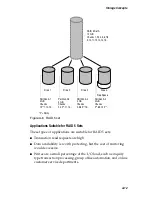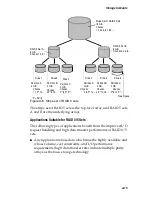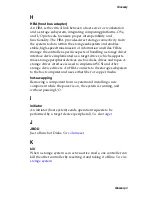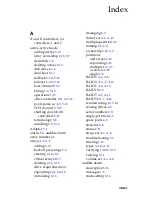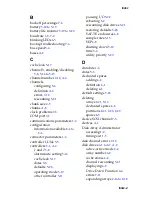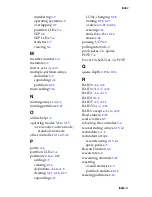
B-3
SAF-TE Implementation
Administrator Utility SEP Configuration
Options
SAF-TE configuration settings are automatically enabled when the
DuraStor 6200S RAID controller controller is installed in an
enclosure that contains a SEP. No changes are required to the
default configuration settings to support SAF-TE. However, the
user can configure configure the SEP LUNs and the SEP settings to
fit the user’s specific environment. See
Changing the SEP LUN
on
page 6-8
and
Changing the Additional SEP Settings
on page 6-9
for
further details.
Host Communication Methods
The host system can communicate to the SEPs along three different
paths. The first two paths are through the controller’s host SCSI
connection and the third path is over a serial port.
The first path to the SEPs is a direct connection over the SCSI path,
with the SEP LUNs under the controller’s SCSI target ID using the
standard SAF-TE commands. The LUNs should be set up as
described in
Changing the SEP LUN
on page 6-8
. The SEP LUNs are
logical connections that pass the commands and data through the
internal CAPI code and out to the physical SEPs on the disk
channels.
The second path to the SEPs is over the SCSI path to the controller’s
target ID and the controller’s bridge LUN using CAPI. The host
system talk to all of the SEPs all of the time because the internal
CAPI code
always
maintains a connection to the SEPs on any
system.
By creating a custom host application using the CAPI SDK, the
application can determine when an individual enclosure
component is out of operating specification and alert the user via
emails or pager messages. The added advantage is gaining access
to all of the CAPI data and control features (not just the SAF-TE
functions). CAPI is described in detail in the
CAPI Functional
Specification
. Version 3.0 is available from
www.chaparralnet.com
at
no cost. Ask for the CAPI 3.0 spec., part number 07-0003-305.
The third path to the SEPs is using CAPI (on the host’s serial port)
to connect to the configuration port on the controller. This is the
same port used by the Administrator Utility and is always
available.









